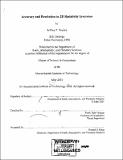Accuracy and resolution in 2D resistivity inversion
Author(s)
Snyder, Jeffrey Z., 1974-
DownloadFull printable version (14.55Mb)
Alternative title
Accuracy and resolution in two dimensional resistivity inversion
Other Contributors
Massachusetts Institute of Technology. Dept. of Earth, Atmospheric, and Planetary Sciences.
Advisor
Frank Dale Morgan.
Terms of use
Metadata
Show full item recordAbstract
Two-dimensional resistivity inversion employing regularization enforces a constraint of smoothness that minimizes error and avoids unrealistically complex solutions to the inverse problem. The insensitivity of surface array data to deeper targets typically presents an under-determined problem for solution by the inversion algorithm, and the smoothing function within the algorithm tends to "smear" tomographic imagery. Together, the physical challenges of electrical resistivity as a geophysical method and the numerical challenges inherent in solving the inverse problem introduce errors in the accuracy of 2D resistivity imagery. It is important to know what surface array geometry will provide data that yields the best results from the inversion. Testing this inversion algorithm on data from several array geometries provides the opportunity to determine the comparative performance of each survey method. By introducing two types of resistive anomalies and varying their location within a synthetic homogeneous half-space, it is possible to generate synthetic data with a forward model algorithm. The data from each array geometry is then inverted in order to illustrate the accuracy and resolution response of the inversion algorithm. The inversion images are converted into binary images after defining a critical resistivity that describes the contrast between background resistivity and target resistivity. The binary images are used as interpretive tools that allow the user to overcome the "smearing" introduced by the inversion. Because of its consistent performance from the margins to the center of an array, a left-right sweep geometry combined with a pseudo section geometry appears to be the best choice for a surface array when there is no knowledge of the subsurface structure or resistivity distribution. The critical resistivity and the area of the anomaly are used to describe the performance of the inversion. When taken as functions of increasing depth, the critical resistivity decreases and the area of anomaly increases, providing a respective correlation with the current density and the degree of smoothness. Initial results by forming a product of critical resistivity and area suggest that it is possible to approximate the product from the original forward model, but further testing is warranted to provide more conclusive results.
Description
Thesis (S.M.)--Massachusetts Institute of Technology, Dept. of Earth, Atmospheric, and Planetary Sciences, 2001. Includes bibliographical references.
Date issued
2001Department
Massachusetts Institute of Technology. Department of Earth, Atmospheric, and Planetary SciencesPublisher
Massachusetts Institute of Technology
Keywords
Earth, Atmospheric, and Planetary Sciences.